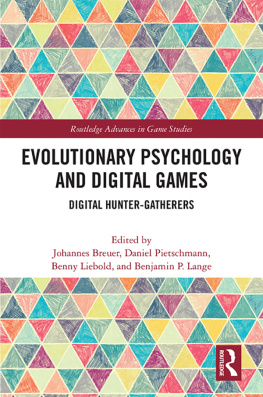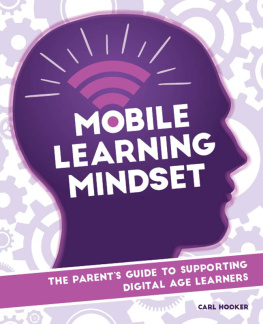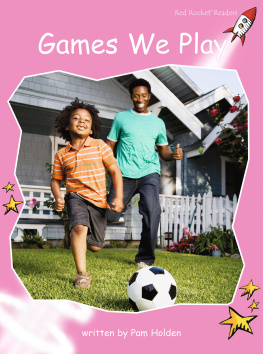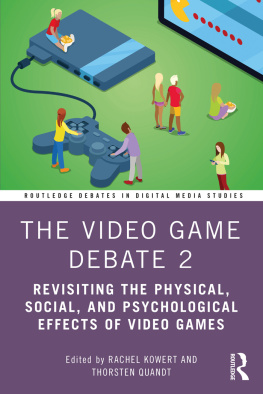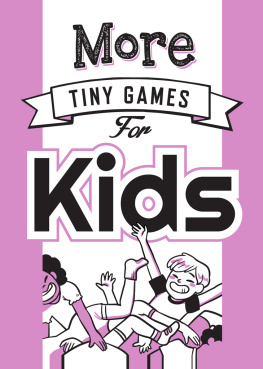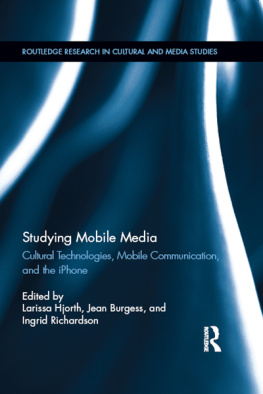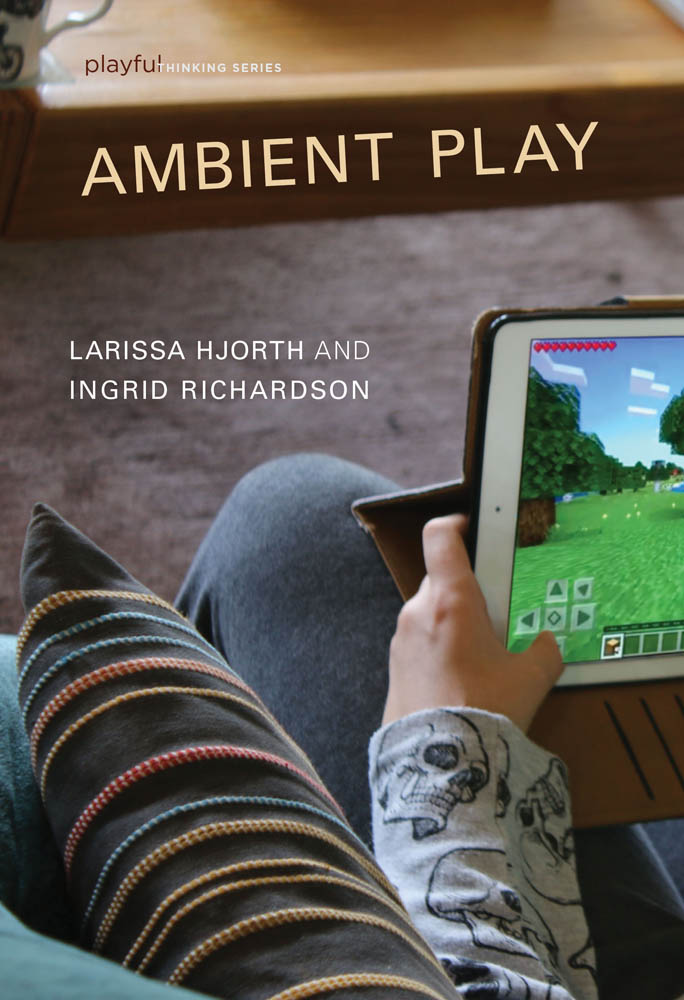
Ambient Play
Playful Thinking
Jesper Juul, Geoffrey Long, William Uricchio, and Mia Consalvo, editors
The Art of Failure: An Essay on the Pain of Playing Video Games, Jesper Juul, 2013
Uncertainty in Games, Greg Costikyan, 2013
Play Matters, Miguel Sicart, 2014
Works of Game: On the Aesthetics of Games and Art, John Sharp, 2015
How Games Move Us: Emotion by Design, Katherine Isbister, 2016
Playing Smart: On Games, Intelligence, and Artificial Intelligence, Julian Togelius, 2018
Fun, Taste, and Games: An Aesthetics of the Idle, Unproductive, and Otherwise Playful, John Sharp and David Thomas, 2019
Real Games: Whats Legitimate and Whats Not in Contemporary Video Games, Mia Consalvo and Christopher A. Paul, 2019
Achievement Relocked: Loss Aversion and Game Design, Geoffrey Engelstein, 2020
Play Like a Feminist, Shira Chess, 2020
Ambient Play, Larissa Hjorth and Ingrid Richardson, 2020
Ambient Play
Larissa Hjorth and Ingrid Richardson
The MIT Press
Cambridge, Massachusetts
London, England
2020 Massachusetts Institute of Technology
All rights reserved. No part of this book may be reproduced in any form by any electronic or mechanical means (including photocopying, recording, or information storage and retrieval) without permission in writing from the publisher.
Library of Congress Cataloging-in-Publication Data
Names: Hjorth, Larissa, author. | Richardson, Ingrid, author.
Title: Ambient play / Larissa Hjorth and Ingrid Richardson.
Description: Cambridge, Massachusetts : The MIT Press, [2020] | Series: Playful thinking | Includes bibliographical references and index.
Identifiers: LCCN 2020000387 | ISBN 9780262044363 (hardcover)
Subjects: LCSH: PlaySocial aspects. | GamesSocial aspects.
Classification: LCC GV14.45 .H56 2020 | DDC 306.4/81dc23
LC record available at https://lccn.loc.gov/2020000387
10 9 8 7 6 5 4 3 2 1
d_r0
To the next generation of ambient players: Zo, Jamie, and Jesper
Contents
Many people (we series editors included) find video games exhilarating, but it can be just as interesting to ponder why that is so. What do video games do? What can they be used for? How do they work? How do they relate to the rest of the world? Why is play both so important and so powerful?
Playful Thinking is a series of short, readable, and argumentative books that share some playfulness and excitement with the games that they are about. Each book in the series is small enough to fit in a backpack or coat pocket and combines depth with readability for any reader interested in playing more thoughtfully or thinking more playfully. This includes, but is by no means limited to, academics, game makers, and curious players.
So we are casting our net wide. Each book in our series provides a blend of new insights and interesting arguments with overviews of knowledge from game studies and other areas. You will see this reflected not just in the range of titles in our series, but in the range of authors creating them. Our basic assumption is simple: video games are such a flourishing medium that any new perspective on them is likely to show us something unseen or forgotten, including those from such unconventional voices as artists, philosophers, or specialists in other industries or fields of study. These books are bridge builders, cross-pollinating both areas with new knowledge and new ways of thinking.
At its heart, this is what Playful Thinking is all about: new ways of thinking about games and new ways of using games to think about the rest of the world.
Jesper Juul
Geoffrey Long
William Uricchio
Mia Consalvo
Larissa and Ingrid would like to thank the human and more-than-human participants from the Australian Research Council (ARC) Discovery Project Games of Being Mobile. They would also like to acknowledge the research assistance of Dr. Brendan Keogh, Dr. William Balmford, and Dr. Olivia Efthimiou, as well as Klare Lanson for her excellent editorial work.
Like many homes around the world, the Madisons household in Adelaide, Australia, is playful in many different ways. Some areas of the house are hubs for social activity and media use, while other spaces are quieter and more contemplative. The emotional fabric of the household follows certain rhythms of play across the spatial organization of the lounge, computer room, and bedrooms.
In the computer room, two desktop computersone PC, the other Macstand ready for use on separate desks. In this room, participants move between games and work, playbour and labor. However, in the communal space of the lounge room, the play texture becomes more complex and adaptable. Here we find a range of devices and play practices. This assemblage includes game consoles (Wii and PlayStation), two iPads, and three iPhones. In the evenings when the parents and their daughter are home, the lounge becomes the focus for interaction and engagement, a highly social space for shared conversation, games, and creative play. This play sometimes includes the Madisons cat Bonnie, who is known to be fond of the iPad game Cat Fishing. As is the case in many homes, playful domestic practices often include family pets, or what Anne Galloway calls our more-than-human companions.
The Madison household contains many stories of play and playfulness. While some of the play activities are more specifically associated with games, other practices are more subtly playful. For example, the lounge is a space for both defined gameplay and more informal ways of being playful. The various modes of play shift between the foreground and background of the familys attention, moving across mobile and stationary media interfaces, traversing the solitary and collaborative activities of the homes cohabitants, and intermingling with the mundane online and offline practices of everyday life. In the domestic environment, this infusion of playfulness throughout the emotional and material space of the home might be described as a kind of ambient play.
The Madison home is one of the sixty households we visited annually over three years (mid-2013 to mid-2016) in five of Australias capital cities: Melbourne, Perth, Adelaide, Sydney, and Brisbane. Our aim was to capture the effect of mobile games on contemporary life. Gaming scholars often discuss mobile games in a vacuum, without understanding how they fit into our day-to-day lives. To understand mobile games is to understand them within the banal and familiar rhythms of everyday life.
Ambient Play aims to contextualize mobile games as part of broader practices of play, both in the home and extending out into neighborhoods, urban public spaces, and online networks. First, we focus on the ways in which householdsas intimate spaces where humans and their companion animals cohabitare transformed by media, and how individual and idiosyncratic media use in turn transforms the spatial composition and emotional cadence of the home. We then explore how mobile games connect domestic forms of play and more public modes of playfulness in urban spaces, and how collaborative play (both networked and face-to-face) is incorporated into these domains.
This book seeks to take mobile games seriously as they expand across different public and private settings in ways that are social, ecological, and even political. As mobile games move across different genres, platforms, practices, and contexts, they are ever present in our everyday lives and become, for many of us, an important means of experiencing and navigating a digitally saturated world. They are also, significantly, conduits of what we call
Next page

